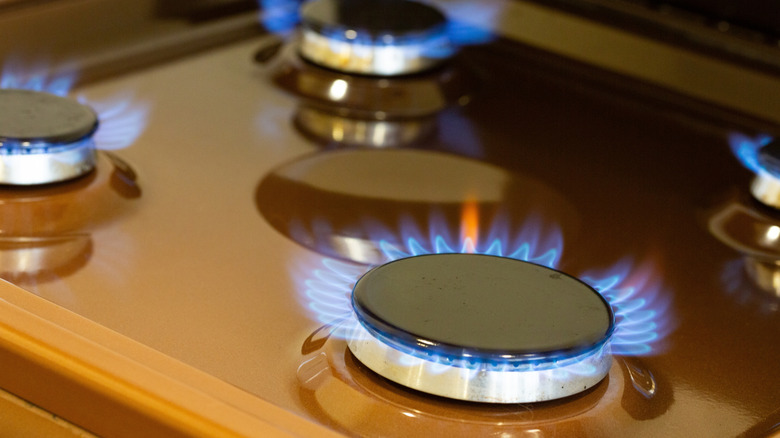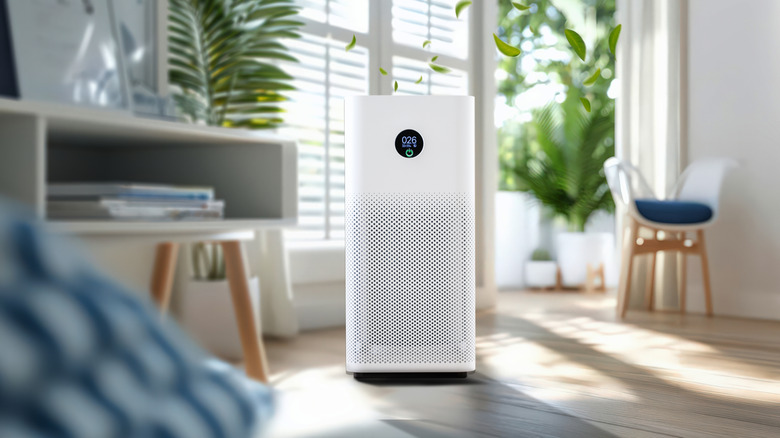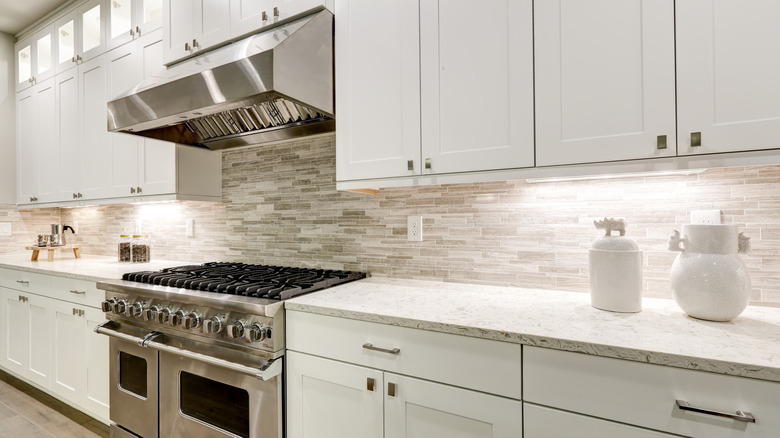The Toxic Problem With Gas Stoves
People love their gas stoves. There was an uproar over an investigation by the Consumer Products Safety Commission that nearly led to a gas stove ban. But what gas stove users might not recognize is that a serious health hazard is entering their kitchens via their gas stoves, and it gets in even if you don't use your stove at all. A chemical called benzene — a colorless or light yellow liquid that evaporates readily into a colorless, sweet-smelling gas – is present in natural gas and has been shown to reach potentially dangerous levels in homes without sufficient ventilation.
Benzene is usually thought of as an industrial pollutant that's used in the manufacture of a number of consumer products, not the products themselves. But it is found in natural gas and gasoline. Research from 2022 that was published in the Environmental Science and Technology journal showed that a gas stove that isn't even on is likely to release benzene into homes, while Stanford University found in 2023 that in some cases, a single burner or a gas oven set to 350 degrees Fahrenheit can produce benzene concentrations at the levels found in secondhand smoke.
Common indoor sources of benzene exposure include glues, paints, furniture waxes, detergents, and other household chemicals. In the short term, inhaled benzene can cause drowsiness, dizziness, an irregular heartbeat, headaches, confusion, and even unconsciousness or death at exceptionally high concentrations. Long-term effects include damage to bone marrow, anemia, reproductive difficulties, and acute myeloid leukemia, according to the American Chemical Society.
Typical regulations and filtration systems probably won't help
While some common sources of benzene are known — cigarette smoking and secondhand smoke, driving, using attached garages, auto exhaust, and industrial emissions — a clear picture of other sources is only starting to emerge. Compared with benzene that might be released from building materials, paints, and adhesives, benzene that enters the home through a gas stove might be easier to deal with. But some of the more obvious routes of addressing benzene contamination aren't likely to produce positive results.
New Department of Energy emissions standards address carbon dioxide emissions from gas stoves, but not benzene emissions, and will only affect 3% of gas stoves in any event. Without regulations to remove benzene, you might consider taking things into your own hands, but that could prove difficult. Consumer-grade air quality monitors don't typically test for benzene levels. Meanwhile, the most commonly available methods of cleaning your air won't have any impact, since electrostatic air filters and HEPA air filtration have no effect on gas concentrations. Carbon air filters can help to some extent, and a few of the popular air purifiers tested included carbon filtration. And other methods of improving indoor air quality, such as keeping HVAC systems well maintained, can help as well.
Strategies that can improve or eliminate the threat of benzene
No single solution is likely to get rid of benzene contamination from all of its many sources, and eliminating the threat from gas stoves alone can prove challenging. Elevated levels of benzene can be found in the home for hours after the offending burner or oven is turned off, and exposure isn't just a problem in the kitchen. Benzene that originates with a gas stove can be found throughout a home in varying levels. And according to the World Health Organization, there is no safe level of benzene exposure.
But the danger of benzene is tied to how much you're exposed to, and there are ways to reduce the amount your gas stove leaves in your home's air. Your number-one ally in this fight is your range hood. What's important about this device, besides simply remembering to use it, is a measurement called "capture efficiency," which describes the amount of gas and particulate matter the range hood can eliminate before it's distributed throughout the home. The Building and Environment journal found that more powerful, larger range hoods have been shown to reduce up to 95% of harmful gases originating at gas stove burners.
The remaining pollutants are typically removed by a home's HVAC air-exchange mechanism, and by being deposited onto surfaces within the home (remember, benzene is a liquid at room temperature and pressure). Obviously, ordinary air exchange will have more of an impact on benzene produced while your stove is off, unless you leave the range hood running all the time ... which is neither the worst nor the cheapest of ideas.


